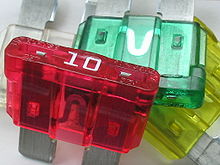fuse
The fuse serves to protect electrical circuits from overload and short circuit. A fuse is a simple protective device that works on the basis of the physical principle of thermal or electromagnetic action. It is one of the most common protective devices used in electrical distribution systems and appliances.
The main task of the fuse is to monitor the current in the electrical circuit. If the current exceeds a certain value, the fuse will quickly open and terminate the electrical circuit, preventing damage to the equipment or fire. Fuses are designed to withstand normal operating current, but in the event of too much current (overload) or a short circuit, they fail immediately, protecting the device and the circuit from damage.
Fuses can have different current and voltage values, which allows them to be adapted to specific electrical circuits and ensure optimal protection. They are available in a variety of sizes and types, including screw-type fuses, tube fuses and miniaturized fuses, which are used in modern appliances and electronic devices.
If the fuse has blown, it must be replaced with a new fuse with the same current and voltage value. Replacing fuses should only be done by qualified professionals to avoid dangerous situations.


























































































































































